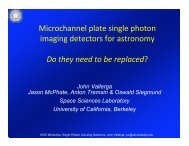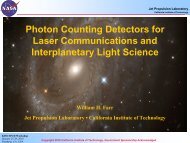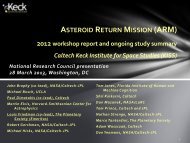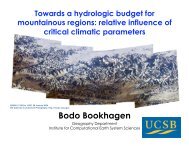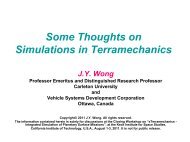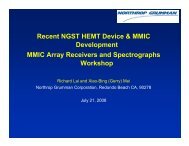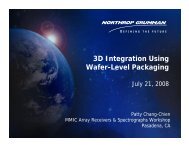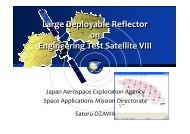DRAFT: RELEASED FOR PUBLIC COMMENTrisk can be reduced via more robust infrastructure, this approach is more costly than reductionsrealized through optimal launch timing and manifesting.Practical, affordable HSF missions result from visiting the most accessible <strong>NEO</strong>s. These missionsreduce IMLEO and the number of launches required because their short durations and minimalpropulsion requirements reduce habitation, consumables, shielding, and trash masses, together withthe volumes required to contain them. Due to the premium associated with <strong>NEO</strong> accessibility innear-term interplanetary HSF, a bigger return on investment is expected from better <strong>NEO</strong> surveysand tracking than from better HSF capability. In the longer term, improved HSF capability will berequired to access progressively more remote (and likely more interesting) <strong>NEO</strong>s leading to Marsorbit missions.3.5 Summary of Key Findings1. Catalog, characterize, and track <strong>NEO</strong>s down to 100-m diameter or less as thoroughly aspossible.2. Survey <strong>NEO</strong>s, particularly those with Earth-like orbits, from a deep space vantage to find themost appropriate HSF mission opportunities sufficiently in advance of their Earth departureseasons.3. <strong>Target</strong> initial HSF missions at the most accessible <strong>NEO</strong>s using conventional technology tothe greatest extent possible.4. Minimize the number of launches and assembly complexity leading to a HSF mission’s Earthdeparture for interplanetary space.5. Identify key HSF technologies and architectures relating to <strong>NEO</strong> mission opportunities.6. Adopt objective mission design metrics, such as IMLEO reflecting performance penaltiesinclusive of Earth departure asymptote declination, clearly documenting their architecturedependencies and assumptions.7. Whenever possible, plan a mission to a sequence of extended Earth departure seasons, likelytargeting multiple distinct <strong>NEO</strong>s, in order to accommodate unintended departure delays.4 <strong>NEO</strong> Characteristics for Safe and Meaningful Human ExplorationThis panel session was chaired by Andy Rivkin (Supervisor of the Planetary Astronomy Sectionin the The Johns Hopkins University Applied Physics Laboratory) and Paul Abell (Lead Scientistfor Planetary Small Bodies, NASA-JSC) and consisted of the following members:• Patrick Michel, Senior Researcher, University of Nice, CNRS, Cote d’Azur Observatory• Lance Benner, Research Scientist, Jet Propulsion Laboratory• Joe Nuth, Senior Scientist, NASA NASA’s Goddard Space Flight CenterDRAFT: RELEASED FOR PUBLIC COMMENT 9
DRAFT: RELEASED FOR PUBLIC COMMENT• Dan Scheeres, Professor, Department of Aerospace Engineering Sciences, University of Colorado• Mike Hess, Chief of the EVA, Robotics, and Crew Systems Operations Division, NASANASA’s Johnson Space CenterIn this session we discussed the known physical characteristics of <strong>NEO</strong>s obtained from spacecraftand ground-based observations. Additional discussion focuses on:• How best to determine the physical characteristics of candidate <strong>NEO</strong> targets that must beknown prior to human exploration (via ground-based and/or space-based assets)• What methods, measurements, and instruments are required to provide the necessary datafor target selection and qualification• When these data should be obtained so as to best inform scientists and engineers designingand planning future human <strong>NEO</strong> exploration missions4.1 <strong>NEO</strong> Population Diversity and Motivations for ExplorationOur understanding of <strong>NEO</strong> physical properties has been evolving since the 1970s, via visible andinfrared reflectance spectroscopy, measurements of albedos, and an increasing number of objectsobserved by radar. More recent work, such as the study of non-gravitational forces, binary andmultiple objects, and geophysics in microgravity environments, has led to rapid and continuingprogress. While there is much yet to learn, it is already clear that a wide range of diversity inphysical properties is present in the <strong>NEO</strong> population.Compositionally, we know from the meteorite collection and reflectance spectra that <strong>NEO</strong>s spana range from metallic to rocky bodies (and mixtures of metal and rock), with the rocky bodiesthemselves spanning a range of compositions from evolved igneous material to undifferentiatedand unprocessed material including water- and organic-rich minerals [6, 7, 8, 9, 10, 11]. Materialunrepresented in the meteorites is also expected to be present in the <strong>NEO</strong> population, most notablyin the form of extinct comets with depleted inactive surfaces and potentially icy interiors [10, 12].While detailed work is required to determine <strong>NEO</strong> compositions to scientifically useful precisions, itis clear that the overwhelming majority of <strong>NEO</strong>s are rocky rather than metallic, and that chondritic(unprocessed) material likely dominates the rocky bodies.The albedos of <strong>NEO</strong>s range from roughly 4% to 30% for the most common types, but can reachhigher or lower values in rare instances [13]. These albedos are directly relevant to the surfacetemperatures that will be found at <strong>NEO</strong>s and the operating temperatures required for spacecraftin a <strong>NEO</strong>’s vicinity. Thermal inertias are typically lower than that of bare rock (and thus indicativeof regolith coatings) but are higher than what is found on large asteroids and the Moon (and thusindicative of larger particle sizes than what is found in those powdery regoliths) [14]. Rotationrates vary from the order of a few minutes for some smaller (≈ 10 m) bodies to days to weeksfor some objects. At sizes larger than roughly 150 m, objects are not seen to rotate with periodsshorter than ≈ 2.2 hours [15, 16]. There also appears to be a correlation between rotation rateand satellite systems, with satellites found for two-thirds of <strong>NEO</strong>s 300 m and larger with rotationperiods between 2.2 and 2.8 hours.DRAFT: RELEASED FOR PUBLIC COMMENT 10




